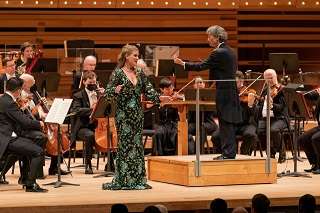|
Back
Kent Nagano Returns to a Wildly Appreciative Audience in Montreal Montreal
Maison symphonique de Montréal, Place des Arts
11/22/2022 - & November 23, 24*, 2022
Franz Schubert: Symphony No. 3, D. 200
Wolfgang Amadè [*] Mozart: Exsultate jubilate, K. 165 – Symphony No. 41 in C major “Jupiter”, K. 551
Jane Archibald (Soprano)
Orchestre symphonique de Montréal, Kent Nagano (Conductor)

J. Archibald, K. Nagano (© Antoine Saito)
Montreal’s Maison symphonique was packed to the rafters on November 24, the third consecutive evening led by returning Conductor Emeritus Kent Nagano. He conducted a reduced Orchestre symphonique de Montréal in a slight program of Mozart and Schubert. There was so much applause after every movement of the two symphonies that Nagano felt obliged to offer a gracious bow after each movement. The program opened with a clean, crisp performance of Schubert’s Symphony No. 3, one of almost 200 works he composed in 1815 at the age of 19. Nagano maintained balance among the orchestral sections, with appropriate contrasts and respect to dynamic indications such as the soft and delicate opening to the second movement, and created a riveting crescendo to the climax of the fourth.
Soprano Jane Archibald, a Nova Scotia native (and former member of the Vienna State Opera ensemble) delighted the audience with Mozart’s Exsultate jubilate—another product of a young genius, this time from the tender age of 16! Resplendent in a gown of emerald-green and gold sequins on black, Ms Archibald sang the joyous work with assurance, subtlety and sensitivity. Her dusky, full‑bodied voice and generous use of vibrato heard in the opening “Exsultate” and “Tu virginem corona” passages effectively gave way to the buoyant coloratura delights of the concluding “Alleluia.”
Without intermission, Nagano concluded with a work of Mozart’s maturity—his monumental last symphony, No. 41, the Jupiter, later so‑named for its lofty ambitions. But in Nagano’s hands it took a while to reach Olympian heights. The orchestra raced through the first movement with little attention to color or interpretation. The second lacked warmth and pulse, and the third began too timidly and suffered from a lack of focus. The musicians found their footing, however, in the magnificent final movement with its wealth of melodic ideas and counterpoint. The strings sang, woodwinds and brass played with verve, and a surging pulse sustained excitement through to a glorious conclusion.
[*] “The reader of Mozart’s letters must soon grow accustomed to the numerous permutations to which the composer, who was baptized Joannes Chrysostomus Wolfgangus Theophilus Mozart, subjected his own name, apparently just for the fun of it. Thus, we are not surprised to find such variations on the surname as “De Mozartini,” “Mozartus,” or “Mozarty,” though we may be momentarily startled by such anagrammatical variants as “Trazom” or “Romzntz.” The name Wolfgang, though occasionally “Gangflow,” underwent comparatively few transformations. It is the last of Mozart’s forenames, Theophilus, that was subjected to the greatest variety of metamorphoses. Writing to his Augsburg publisher shortly after the birth, on 27 January 1756, of his son, Leopold Mozart noted, “The boy is called Joannes Chrisostomos, Wolfgang, Gottlieb,” thus translating the Greek Theophilus into the German Gottlieb, a form that was preserved – as “J.G. Wolfgang Mozart” – on the earliest of the child’s published works to bear opus numbers. From about 1770 on, Mozart several times referred to himself as “Wolfgango Amadeo Mozart,” but by 1778 he had adopted his favorite – and almost invariable – form of the name, Amadè or Amadé, with occasional ventures into Amadi or the Latinized Amadeus, the latter having originated as early as 1774 in a typically jesting message to his sister. (The almost universal adoption of the form Amadeus is a posthumous process, propelled in large part, I believe, by the wide circulation of Breitkopf & Härtel’s Œuvres complètes de Wolfgang Amadeus Mozart (1798‑1806).”
From Mozart: A Life by Maynard Solomon (HarperCollins, 1995), p. 277
Earl Arthur Love
|